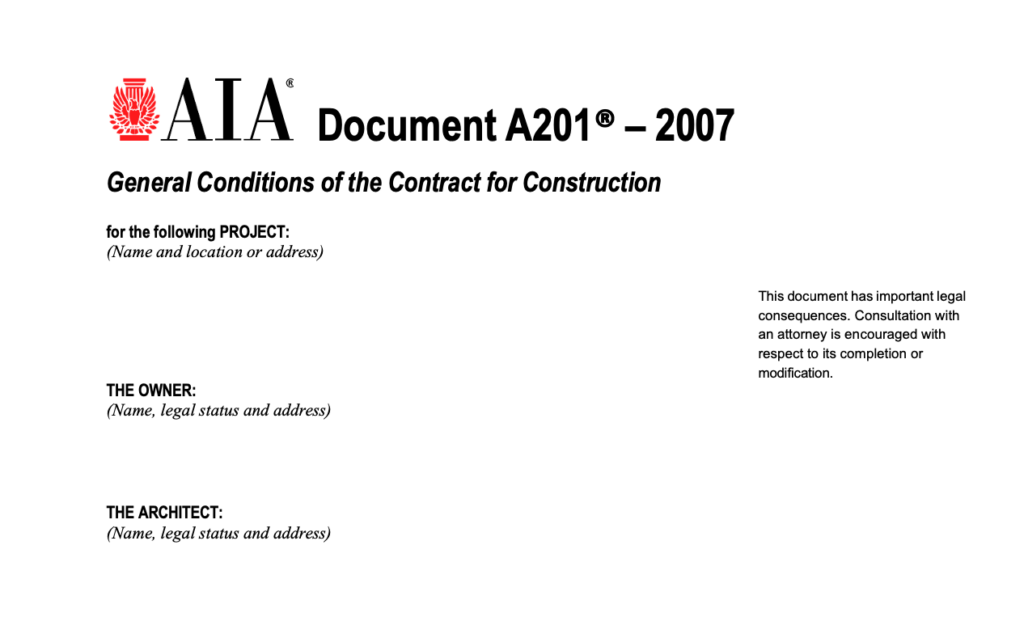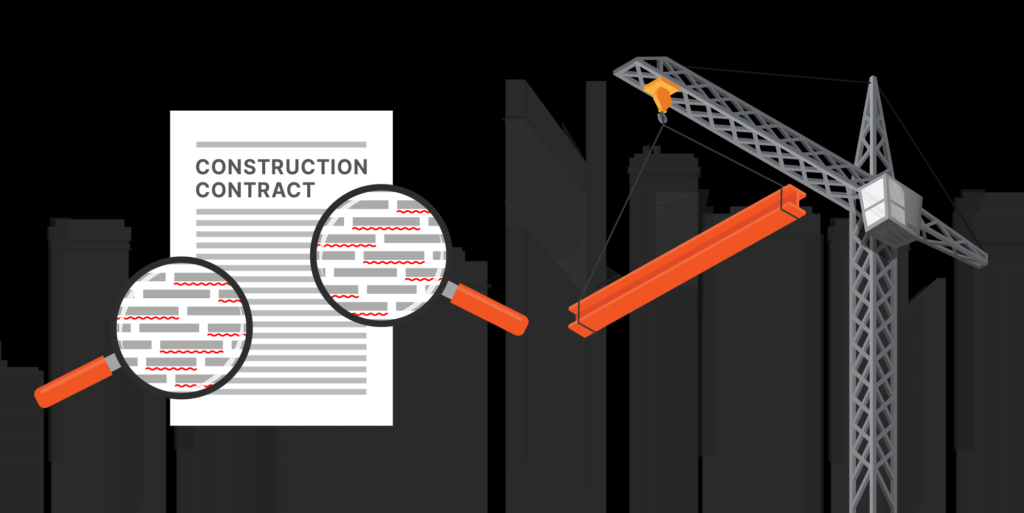— 8 min read
The AIA A201 General Conditions Explained for Contractors & Owners


Last Updated Oct 7, 2024

Alisa Schneider
AIA Contract Documents
Alisa D. Schneider, Esq. is Manager and Counsel on the AIA Contract Documents team. Utilizing over 16 years of professional construction and legal expertise, Alisa works with the AIA Documents Committee to create and revise AIA Contract Documents’ standard form agreements and associated material.

Kristen Frisa
Contributing Writer
112 articles
Kristen Frisa is a contributing writer for Procore. She also contributes to a variety of industry publications as a freelance writer focused on finance and construction technology. Kristen holds a Bachelor of Arts in Philosophy and History from Western University, with a post-graduate certificate in journalism from Sheridan College. She lives in Ontario, Canada.
Last Updated Oct 7, 2024

Before beginning a project, owners, architects and contractors need to define and agree upon their relationship to each other, so that everyone’s expectations can be met. The AIA document A201 details the terms and conditions that set forth the rights and responsibilities of those parties on a construction project — and sets a foundation for other documents that adopt it by reference.
This article will generally discuss the different sections of the A201 form, how construction professionals use it and best practices for using the document successfully.
Learn more about general conditions in construction contracts.
Table of contents
Understanding the A201

The AIA Document A201 – 2017 General Conditions of the Contract for Construction is the industry standard general conditions document that defines the relationships between the:
- Owner and architect
- Owner and contractor
- Contractor and subcontractor
The AIA A201 contains the terms and conditions that set forth the rights and responsibilities between the above parties in a construction project. This document is adopted by reference in subcontracts and other contract documents -- parties to other documents that reference the general conditions are also bound by its terms.
Relationship to other AIA Documents
The A201 is used as a foundation for other contract documents and will be referenced throughout the project’s contracts. The A201 lays out relationships between the owner, architect, and contractor that other documents can rely on and refer to:
- A401 (Contractor-Subcontractor agreement) Buy
For instance, AIA Document A101 contains a section that states payment can be withheld from contractors by architects if work remains uncorrected. This section will then reference the A201 document on the specifics of how and when an architect may withhold payments, how and when the owner and contractor need to be notified on the withholding, and any rules that apply to why payment can be withheld.
A201 helps to keep the owner-contractor agreements and the owner-architect agreements from being extremely long by adopting the general conditions by reference.
By using the two documents together, the parties understand the general terms and conditions of the project, but then can tailor the owner-architect or owner-contractor agreement for special conditions specific to that project. For example, the owner and contractor can use and understand the terms of the A201 apply without including them all in the A101 document.
Sections of the A201
The general conditions document is broken into 15 articles, each laying out terms and conditions for the project:
- General Provisions
- Owner
- Contractor
- Architect
- Subcontractors
- Construction by Owner or by Separate Contractors
- Changes in the Work
- Time
- Payments and Completion
- Protection of Persons and Property
- Insurance and Bonds
- Uncovering and Correction of Work
- Miscellaneous Provisions
- Termination or Suspension of the Contract
- Claims and Disputes
Important Terms & Provisions
General Provisions and Contractual Relationships
The first part of the document defines common terms and concepts used throughout the contract documents. The following sections define and lay out the rights and responsibilities of each party, including the owner, contractor, architect and subcontractors on the project.
Changes in Work, Contract Time, Work Progress, Completion and Delays
The general conditions address changes in the work, including design, drawings, specifications, or the construction work itself that arise after the contract is executed. Contract time (the period of performing work), work progress, completion, and delays are addressed to include information regarding what happens if there are delays in the project timeline.
Payment Procedures
The A201 lays out some rules for payment, including how pay applications should be prepared and submitted, when a schedule of values is required and the responsibility of the contractor to ensure the owner is free and clear of liens.
Terms and conditions related to payment application itself are within the A201, like the requirement for parties to submit the application within 10 days before the date established for each progress payment. A201 will also say that the architect needs to review the pay app, and what happens once the architect reviews it, including issuance of a certificate for payment and finally owner payment. The A101, by contrast, will go into details about the contract sum amount and the period of performance covered by each pay app.
Substantial Completion and Final Completion
A201 defines substantial completion, which generally means when the work is sufficiently complete so that the Owner can occupy or utilize the work for its intended use. Substantial completion can mean all of the work or a portion of the work. Importantly, substantial completion is typically the point at which the contractor’s warranty begins to run. The A201 also identifies the roles and responsibilities of the architect and contractor related to the final inspection and acceptance of the work.
Learn more: AIA Document G704™-2017 Certificate of Substantial Completion
Worker Safety, Risk Allocation, Insurance and Bonds
General conditions in the A201 outline safety procedures and precautions, address hazardous materials or substances, and how the contractor can respond to emergencies affecting the safety of persons or property.
The general conditions also include insurance requirements. The A201 broadly states which insurances are required for the contractor and owner. Other documents — like the AIA Document A101–2017 Exhibit A Insurance and Bonds — will go into more detail.
For example, the A101-2017 Exhibit A not only provides more detail regarding the contractor’s insurance coverage required for commercial general liability, automobile liability, workers’ compensation, and employers’ liability insurance, but it also allows the owner and contractor to include project-specific insurance, like asbestos abatement liability insurance if it is required for the project. Terms regarding waivers of subrogation, performance bonds and payment bonds are also included in the A201.
Correcting Nonconforming Work
The A201 sets out the duties of the contractor related to when the work must remain uncovered, when the work must be uncovered for examination by the architect, corrections of nonconforming work and when the nonconforming work may be accepted by the owner.
Termination/Suspension of the Contract and Dispute Resolution
A201 sets out terms and conditions regarding contract termination by either the contractor or the owner, or for the owner to suspend the work. It lays the ground rules for filing a claim, including who must be notified, the work that happens while the claim is pending, and the requirements for mediation and arbitration regarding all claims.
Miscellaneous Provisions
A201 contains miscellaneous provisions, including governing law, successors and assigns, rights and remedies, responsibilities for testing and inspection required during the project, and the default interest rate for payments due and unpaid.
Stay updated on what’s happening in construction.
Subscribe to Blueprint, Procore’s free construction newsletter, to get content from industry experts delivered straight to your inbox.

How the A201 Impacts Subcontractors
The way A201 impacts subcontractors varies from project to project, depending on the relationship between the architect, contractors and subcontractors. That being said, subcontractors brought onto a project on which the A201 applies may be beholden to its rules. Because these provisions “flow down” to subcontracts, subs should review and understand all contract documents between the owner and the general contractor before signing on with the general contractor themselves.
The A401 is the subcontract agreement between the owner and subcontractor, and that agreement adopts the A201 by reference as well. The A401 generally indicates that the general conditions of the A201 govern the subcontract, except to the extent of a conflict with a specific term or condition contained within the subcontract.
Negotiating A201 Terms & Language
The A201 is a standard form of agreement, meaning it's available for construction owners, architects, and contractors to use and alter according to their needs. However, there is one important caution to keep in mind: Changes or additions to the terms within the A201 will affect the relationship between and possibly change the corresponding owner-architect, owner-contractor, and owner-subcontractor agreements.
Any changes should be made cautiously with this ripple-down effect in mind. Any party subject to the terms and conditions of the A201 or documents that refer back to it should thoroughly read them for any alterations that will have an impact.
Additions and Deletions Reports
Although the A201 is designed as a template that users can alter as they wish, changes to AIA Contract Documents’ standard form agreements are always accompanied by an additions and deletions report that shows every red line, every strike-through, every change to original language and new language that's added. Contractors should always fully read and understand the documents they sign, but the additions and deletions report calls special attention to the changes made to documents.
Legal Repercussions of Changes
Before making changes to A201 for a specific project, it's always a good idea to seek legal counsel to understand the impact of those changes and how they will flow down to other contract documents that incorporate its conditions.
Recent changes to the A201
The most recent update to the A201 was in 2017. Without reviewing them all, here are two important changes that were made between the 2007 and 2017 versions:
- A201-2017 expanded the contractor's scheduling requirements to include important project dates and milestones, an apportionment of the work by trade or building system, and the time required to complete each portion of the work. This detailed schedule allows the document to be more flexible for various types and sizes of projects
- A201-2017 also moved many of the insurance requirements to a separate exhibit form attached to the owner-contractor agreement.
Outline project relationships to set a strong foundation.
A201 is integral to the owner-architect, owner-contractor and contractor-subcontractor agreements. It sets out the terms and conditions of the relationships between the parties involved in a construction project.
Contractors should always fully read and understand the A201, as well as any other contract documents, before signing the agreement. In fact, as the documents are integrated, it's a good idea to open all documents to read them together, checking on sections referenced in another document. If there's an A101 in front of a contractor that incorporates an A201, have them open on side-by-side screens, and ensure full understanding of the way the contract integrates the general conditions into its use.
Was this article helpful?
Thank you for your submission.
94%
6%
You voted that this article was . Was this a mistake? If so, change your vote
Scroll less, learn more about construction.
Subscribe to The Blueprint, Procore’s construction newsletter, to get content from industry experts delivered straight to your inbox.
By clicking this button, you agree to our Privacy Notice and Terms of Service.
Thank you!
You’re signed up to receive The Blueprint newsletter from Procore. You can unsubscribe at any time.
Categories:
Construction Contract, Financial Management, Preconstruction
Written by

Alisa Schneider
AIA Contract Documents | Manager and Counsel
Alisa D. Schneider, Esq. is Manager and Counsel on the AIA Contract Documents team. Utilizing over 16 years of professional construction and legal expertise, Alisa works with the AIA Documents Committee to create and revise AIA Contract Documents’ standard form agreements and associated material.
View profile
Kristen Frisa
Contributing Writer | Procore
112 articles
Kristen Frisa is a contributing writer for Procore. She also contributes to a variety of industry publications as a freelance writer focused on finance and construction technology. Kristen holds a Bachelor of Arts in Philosophy and History from Western University, with a post-graduate certificate in journalism from Sheridan College. She lives in Ontario, Canada.
View profileExplore more helpful resources

Using Standard Operating Procedures for Better Contract Management
Every construction project is different, meaning that GCs have to be continually agile and strategic about applying their experience. Major categories change from project to project, from the owner to...

Understanding Supplementary Conditions on Construction Contracts
No two construction projects are exactly alike — and the same goes for construction contracts. Even when using a standard contract form, owners and contractors sometimes use supplementary conditions to...

A Straightforward Guide to Construction Contract Review
Construction contracts are like the glue for the project team. They’re the ties that bind the working relationships and goals for the project, containing information about responsibilities, liabilities and processes...

Escalation Clauses in Construction Contracts: When and How They Apply
In construction contracts, an escalation clause allows for the escalation of a certain price for labor or materials to be used in a construction project. This type of clause is most...
Free Tools
Calculators
Use our calculators to estimate the cost of construction materials for your next project.
Templates
Find a template to help you with your construction project tasks.
Material Price Tracker
Get the latest U.S. retail prices and view historical trends for common building materials.
Glossary
Explore key terms and phrases used in the industry.
